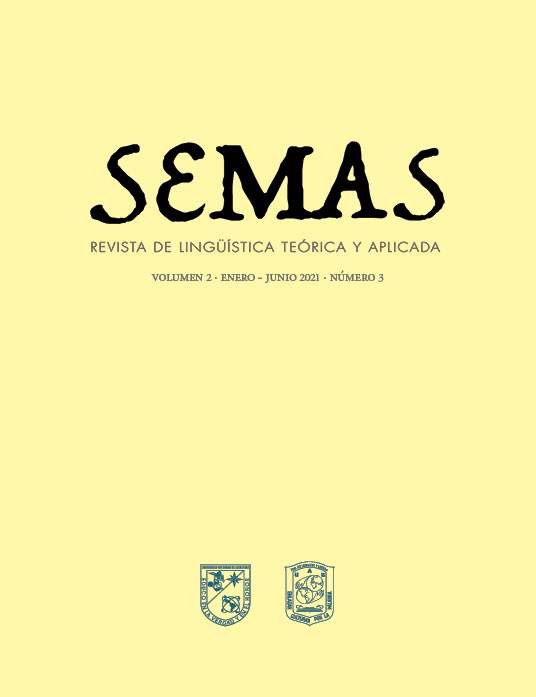Abstract
Word recognition was studied with native Spanish-speaking adults learning Italian as a new language. For this purpose, word type and frequency were selected as main conditions. Two tasks consisting of 80 pairs of words were presented to 11 participants, the first one being a passive association task and the second one a verification task. The measures obtained for the analysis were percentage of correct answers and reaction times. Cognates yielded higher percentages of correct answers and faster reaction times than noncognates. Furthermore, an interaction was identified between cognate status and word frequency, with high frequency words favoring faster reaction times for cognates only. It can be concluded that the recognition of new Italian vocabulary by L1 Spanish speakers is faster and more accurate during initial stages of learning when the targets are cognates, even more so when they are high frequency words in their native language.
References
Barcelos, L. (2016). O accesso lexical em trilíngues brasileiros falantes de português, inglês e francês (tesis de maestría). Universidade Federal do Rio Grande do Sul, Porto Alegre, Brazil.
Brenders, P., Van Hell, J. G. & Dijkstra, T. (2011). “Word recognition in child second language learners: Evidence from cognates and false friends.”Journal of Experimental Child Psychology, 109(4), pp. 383-396.
Carreiras, M., Perea, M. & Grainger, J. (1997). “Effects of orthographic neigh-borhood in visual word recognition: Cross-task comparisons.” Journal of Experimental Psychology: Learning Memory and Cognition, 23(4), pp. 857-871.
Diependaele, K., Lemhöfer, K. & Brysbaert, M. (2013). “The word fre-quency effect in first- and second-language word recognition: A lexical entrenchment account.” Quarterly Journal of Experimental Psychology, 66(5), pp. 843-863.
Dijkstra, T. (2005). “Bilingual Visual Word Recognition and Lexical Access.” En J. F. Kroll and A. M. B. De Groot (Eds.), Handbook of Bilingualism: Psycholinguistic approaches (pp. 178-201). Oxford: Oxford University Press.
Duyck, W., Van Assche, E., Drieghe, D. & Hartsuiker, R. J. (2007). “Visual Word Recognition by Bilinguals in a Sentence Context: Evidence for Nonse-lective Lexical Access.” Journal of Experimental Psychology: Learning Memory and Cognition, 33(4), pp. 663-679.
Lemhöfer, K., Dijkstra, T. & Michel, M. (2004). “Three languages, one ECHO: Cognate effects in trilingual word recognition.” Language and Cognitive Pro-cesses, 19(5), pp. 585-611.
Lemhöfer, K. & Dijkstra, T. (2004). “Recognizing cognates and interlingual homographs: Effects of code similarity in language-specific and generalized lexical decision.” Memory & Cognition, 32(4), pp. 533-550.
Lotto, L. & De Groot, A. M. B. (1998). “Effects of learning method and word type on acquiring vocabulary in an unfamiliar language.” Language Lear-ning, 48(1), pp. 31-69.
Peeters, D., Dijkstra, T. & Grainger, J. (2013). “The representation and proces-sing of identical cognates by late bilinguals: RT and ERP effects.” Journal of Memory and Language, 68(4), pp. 315-332.
Peirce, J. W., Gray, J. R., Simpson, S., MacAskill, M. R., Höchenberger, R., Sogo, H., Kastman, E. & Lindeløv, J. (2019). “PsychoPy2: experiments in behavior made easy.” Behavior Research Methods, 51(1), pp. 195-203.
Potter, M. C., So, K.-F., Von Eckardt, B. & Feldman, L. B. (1984). “Lexical and conceptual representation in beginning and proficient bilinguals.” Journal of Verbal Learning and Verbal Behavior, 23, pp. 23-38.
Sánchez-Casas, R. & García-Albea, J. E. (2005). “The representation of cog-nate and noncognate words in bilingual memory. Can cognate status be characterized as a special kind of morphological relation?” En J.F Kroll & A. M. B. De Groot (Eds.), Handbook of Bilingualism: Psycholinguistic approaches(pp. 226-250). Oxford: Oxford University Press.
Scarborough, D. L., Gerard, L. & Cortese, C. (1984). “Independence of lexical access in bilingual word recognition.” Journal of Verbal Learning and Verbal Behavior, 23, pp. 84-99.
Soares, C. & Grosjean, F. (1984). “Bilinguals in a monolingual and a bilingual speech mode: The effect on lexical access.” Memory & Cognition, 12, pp. 380-386.
Szubko-Sitarek, W. (2011). “Cognate facilitation effects in trilingual word recogni-t ion.” Studies in Second Language Learning and Teaching, 1(2), pp. 189-208.
RStudio Team (2015). RStudio: Integrated Development for R. RStudio, Inc., Boston, MA. http://www.rstudio.com/.
Zhu, Y. & Mok, P. P. K. (2020). “Visual recognition of cognates and interlin-gual homographs in two non-native languages: Evidence from Asian adult trilinguals.” Linguistic Approaches to Bilingualism, 10(4), pp. 441- 470.

This work is licensed under a Creative Commons Attribution 4.0 International License.
Copyright (c) 2021 Semas

